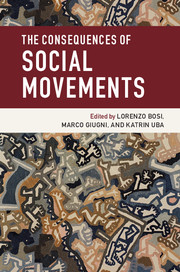Book contents
- Frontmatter
- Contents
- List of figures
- List of tables
- List of contributors
- Introduction
- Part I People
- Part II Policies
- Part III Institutions
- 11 The impact of social movements on political parties
- 12 Watershed events and changes in public order management systems: organizational adaptation as a social movement outcome
- 13 The institutionalization processes of a neo-Nazi movement party: securing social movement outcomes
- 14 Incorporation and democratization: the long-term process of institutionalization of the Northern Ireland Civil Rights Movement
- Conclusion
- Index
- References
11 - The impact of social movements on political parties
from Part III - Institutions
Published online by Cambridge University Press: 05 January 2016
- Frontmatter
- Contents
- List of figures
- List of tables
- List of contributors
- Introduction
- Part I People
- Part II Policies
- Part III Institutions
- 11 The impact of social movements on political parties
- 12 Watershed events and changes in public order management systems: organizational adaptation as a social movement outcome
- 13 The institutionalization processes of a neo-Nazi movement party: securing social movement outcomes
- 14 Incorporation and democratization: the long-term process of institutionalization of the Northern Ireland Civil Rights Movement
- Conclusion
- Index
- References
Summary
Introduction
The representative system does not function as representation of the people […]. We do not want to go to a demonstration and listen to speeches from party representatives. We want to take our future into our hands!
The citation from Dutch ecology activists reported above is hardly exceptional for social movements. They are indeed typical for the way in which most social movements conceive political parties: as hierarchical organizations, self-insulated, remote from the citizenry and inattentive to social change. Yet, social movements, including Dutch ecologists, have established various forms of interaction with parties, including the establishment of umbrella organizations and the organization of common protest actions. Of course, social movements are loosely connected informal networks of individuals, groups and organizations (Diani 1995), whose heterogeneity leads to different positions within the movements themselves. Thus, there may be groups refusing any involvement with parties. Yet, parties play such a critical role for social movements’ political outcomes that they hardly can be ignored. If they are willing to succeed in influencing and reforming public policy, social movements must broaden their support and be backed by insiders, i.e., mediators and reference groups willing to take up their claims in the institutional arenas (Amenta et al. 1992; Kriesi et al. 1995; Tarrow 1994; Giugni and Passy 1998; Rucht 2004). However, despite the importance of the social movement-party interactions for the movements’ outcomes, parties are conspicuously absent from mainstream literature on social movements.
This chapter has two main objectives. The first is to encourage social movement research to pay greater attention to political parties. If having an impact on parties may appear a negligible and unsatisfactory outcome vis-à-vis the broader political objectives that social movements aim to achieve, parties are nonetheless the first and fundamental barrier that social movements’ demands have to overcome in order to gain access to the institutional environment. In other words, whether social movements manage to have an impact on parties and the degree to which impact takes place is crucial for the broader political goals of the movements.
- Type
- Chapter
- Information
- The Consequences of Social Movements , pp. 263 - 284Publisher: Cambridge University PressPrint publication year: 2016
References
- 9
- Cited by



